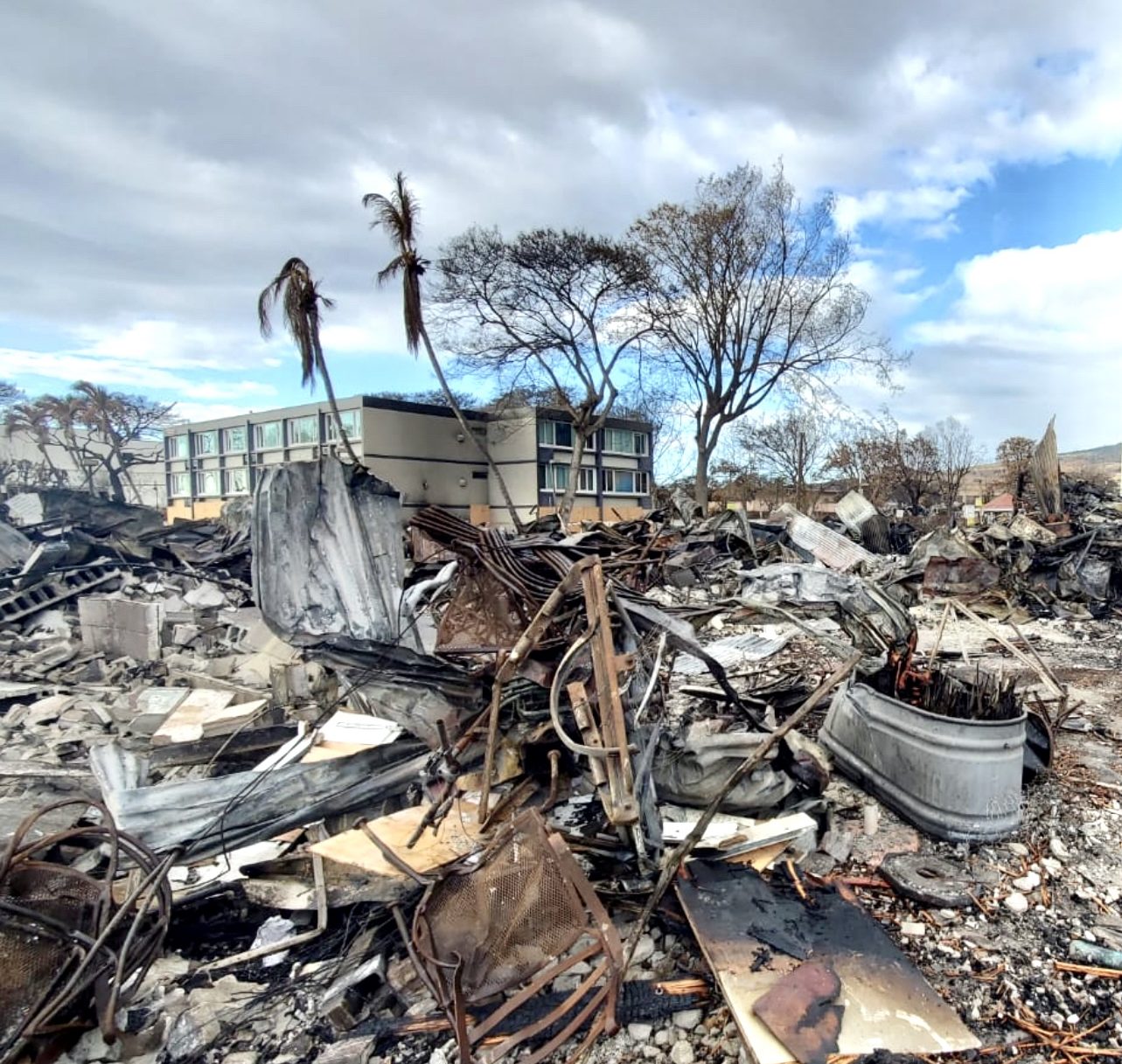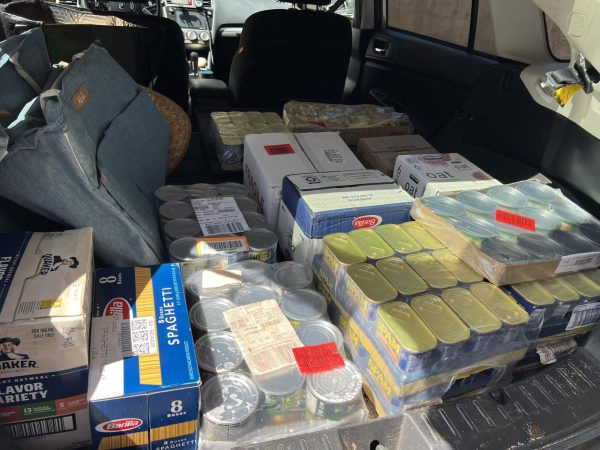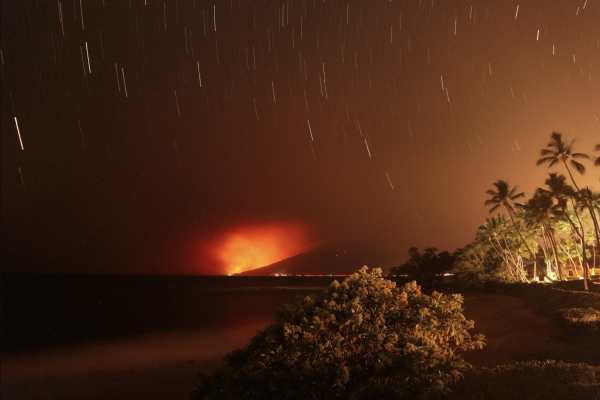
Aug. 8, 3:30 p.m. HST – Lahaina, Hawaii
Explosions reverberate throughout West Maui. Buildings go up in flames one after the other, collapsing in on themselves and creating billowing clouds of ash.
Thick, black smoke rolls south across Lahaina as downed power lines cut communications across the island; Lahaina is an isolated apocalypse zone.
Vehicles jam the streets – drivers who were quick enough to pack their cars and get onto the road desperately try to escape the city before they are engulfed in flames.
Parents carry their children and tightly grasp the hands of panicked teenagers as they run into the traffic, begging drivers to take their family somewhere, anywhere away from the inferno of Lahaina.
Residents fill the sidewalks, carrying bags and suitcases, fleeing the fire and the choking smoke with what little they grabbed from their homes.
People on the westmost side of the city, cornered by the flames and smoke, jump into the Pacific Ocean to stay alive. Many don’t.
Evacuees abandon their past lives as the fire ravages over 200 years of history and ancestry. Hundreds of people work their way to the other side of the island. Some take a direct route, packing up their cars and driving as far as possible. Some flee to wind safety shelters littered around the mountain’s west side and watch as the fires grow closer and closer until they must evacuate again.
Within hours, Lahaina is gone.
What started as a three-acre brush fire on the side of Lahainaluna Road declared 100% contained at 9 a.m. reportedly had an afternoon flare-up six hours later. The County of Maui promptly released evacuation notices for the Lahaina Bypass, Lahainaluna Road, and Hale Mahaolu vicinities as the American Red Cross opened up the Lahaina Civic Center as an evacuation site.
However, according to John Bravender, the warning coordination meteorologist at the National Weather Service (NWS) in Honolulu, this seemingly sudden wildfire was not unpredicted.
There were exacerbated dry conditions and pretty low relative humidity, which can lead to extreme wildfire growth. — John Bravender
Within the NWS Honolulu office, a discussion of possible fire risks started on Aug. 1 due to worsening weather conditions and overgrown brush. Still, it was deemed relatively unimportant due to Hurricane Dora’s increasing presence. Muted concern over the wildfire risk grew on Aug. 4, and a Fire Weather Watch and Red Flag Warning was issued from Aug. 6 to Aug. 9.
“There were exacerbated dry conditions and pretty low relative humidity, which can lead to extreme wildfire growth,” Bravender said.
Hurricane Dora was one of the culprits of the intensified harsh weather conditions starting on July 31.
“Dora had some influence tightening the pressure gradient related to the strong winds, but its influence was more indirect,” Bravender said. “So that’s where we’re struggling – How much of it was Dora? How much of it was just strong trade winds?”
Dora was also one of the 46 Category 4 hurricanes to develop in the Pacific since 2010. Comparatively, only 25 Pacific Category 4 hurricanes developed in 1970-1983. A Category 4 hurricane is determined by its peak sustained wind speed of 130 to 156 mph.
While Dora caused extreme winds and parched weather, abundant dried vegetation resulting from increasing heat extremes throughout the summer and provided the perfect conditions for fast-growing fires. The spark came from the Hawaiian Electric Company’s (HECO) alleged unmaintained powerlines.
The lawsuit the Country of Maui filed against them states that HECO failed to power down their grid despite a Red Flag Warning issued on Aug. 7. The strong winds downed their energized powerlines and allegedly ignited the dry vegetation. These systematic failures caused four fires across Maui and burnt over 3,000 acres of land and structures worth an estimated $5.5 billion.
The Maui County Police Department has confirmed at least 97 fatalities, and 12 people are reported missing.
Lisa Agdeppa, a fifth-generation Maui native, was driving home from work on Aug. 8 at about 1:30 p.m. when she noticed something was wrong.
The morning prior, large sections of the Lahaina area lost power, including her house, but Agdeppa still showed up to her work in downtown Lahaina. The winds picked up speed outside throughout the day, but she didn’t comprehend how extreme they were until she started to drive home.
“The trees were just bending so low. And there was a metal roof, twisted and crumpled around a pole,” Agdeppa said. “If it weren’t for that pole to have stopped the metal roof from flying further, it would’ve gone into the shopping center.”
Once home, Agdeppa took a nap as her husband and his mother fruitlessly attempted to keep the grass clear of fallen tree branches so they wouldn’t have to deal with it later. She awoke at 3:30 p.m. to a rapid succession of explosions from Lahaina.
Startled awake, Agdeppa found her husband outside, struggling to tie down their canoes and looking toward the sound of explosions. They could only see dense, black smoke spanning Lahaina and reaching a mere few blocks from their home.
“We were wondering, well, what’s going on? And we didn’t have any news; we didn’t have any communication whatsoever with anybody,” Agdeppa said. “Not knowing what to do, whether we need to leave, I look at my husband, and we’re like, we should talk.”
Deciding to pack just the necessities on the firm belief they would return home, Agdeppa grabbed toiletries, clothes, a photograph of her kids, a leather-bound journal, a necklace with her granddaughter’s picture, and her granddaughter’s ashes.
“I went to put my bags in the car, and then I saw one of my best friends with one slipper on, a suitcase, and her two stepchildren, who were 14 and 10,” Agdeppa said. “Her face was like, ‘I didn’t know where to go.’ She barely escaped her house, which is on Lahainaluna Road. If she hadn’t heard the explosions herself and looked out the window, she probably wouldn’t be here today.”
Feeling responsible for the safety of her friend and two kids, Agdeppa packed up the car and drove them to another friend in Launiupoko, a city south of Lahaina and further up the mountain. She had to say goodbye to her husband and his mother, who refused to leave the home.
“When I said goodbye to my husband, I said, ‘I’ll meet you there. Please come,’” Agdeppa said. “I am so glad that he eventually could convince his mom to get in his car because his mom was prepared to die. She said, ‘I’m not leaving. I’m ready. I’m ready to go with my house.’ But he wouldn’t let that happen; he would put her kicking and screaming in the truck and leave with her if he had to. I’m so glad he did that.”
Her husband and his mother meet them at a friend’s house several hours later. They were emotionally overwhelmed and shell-shocked; it was only 9 p.m., less than six hours after the fires flared up.
“We didn’t even know what to think. And then the next day, we discovered that all of Lahaina burnt,” Agdeppa said. “The next two weeks after that, we were just in a state of shock.”
After moving around hotels and friends’ homes, Agdeppa and her husband applied for Red Cross housing aid at Kaanapali Shores. They plan to stay in the provided condo until they can return to what remains of their home and start rebuilding.
“As soon as we can get water, we don’t even need electricity; I’d go back home,” Agdeppa said. “I’d camp. I’d set up a tent. Even if we got a camper, like the ones on wheels, and parked it outside, I’d live in it. Just to be back at home.”
I’d camp. I’d set up a tent. Even if we got a camper, like the ones on wheels, and parked it outside, I’d live in it. Just to be back at home.
— Lisa Agdeppa
Agdeppa and her husband could visit their home a few days after the fires started once the Maui government deemed the roads safe to open again.
“I know Lahaina like the back of my hand. I grew up here and raised my kids here,” Agdeppa said. “But everything was just ashes; it’s unrecognizable.”
The home had been her husband’s family home for generations. The walls were covered in pictures and legacies; that house held everything and anything significant in his grandparent’s lives to his children’s.
“That’s everything, and there’s nothing tangible anymore. And that’s truly devastating; my husband lost everything,” Agdeppa said. “We had two bags of clothes each. And I had my car, and he had his truck. And that’s it. We really thought we were going to go home.”
A report by the Intergovernmental Panel on Climate Change (IPCC) found the frequency of compound hot, dry, and windy events trends upward with climate change, which is expected to continue in that pattern.
Increasing heat extremes, decreasing cold extremes, and concurrent heat waves and droughts vary directly with the global increase in temperature and cause recurring wildfire risks.
According to Bravender, the drastic flip from Maui’s wetter-than-normal winter to its drier-than-normal summer, which caused the abundant dried vegetation, was partly caused by a general increase in atmospheric and oceanic temperature. The effects of these weather occurrences indicate that the Hawaiian islands are directly impacted by climate change.
As oceans warm, that variability going back and forth from extreme wet to extreme dry proves to be a marker of climate change.
— John Bravender
“As oceans warm, that variability going back and forth from extreme wet to extreme dry proves to be a marker of climate change,” Bravender said. “And it’s not just one or the other. Going back and forth between both, that can be particularly problematic.”
In addition to wildfires, these extreme weather changes can increase Hawaii’s risk of flash floods, to which all islands are already susceptible.
“After a period of arid conditions, the soil dries out and can get very solid. It is not as porous and not as able to absorb water,” Bravender said. “So when it rains, more of it goes to run-off rather than soaking into the ground, and the area ends up with quicker flash flooding.”
Scenario predictions of future average global temperature, spanning 2014 to 2100 and synthesized by the IPCC, have estimated an increase from 0.3 degrees Celsius to 4.7 degrees Celsius. Global effects of this include but are not limited to, decreasing precipitation in the subtropics, a 10 to 25 cm increase in sea level, and an increase in ecological drought intensity.
The Lahaina fire is but one example of the disastrous effect of climate change on the general public; it is currently the deadliest wildfire the US has experienced in over a century. As the Earth continues to warm, these weather events will become more frequent, disastrous, and fatal.
Lahaina wasn’t just a city to its residents and natives, it was an unplanned bazaar of hundreds and hundreds of little shops and restaurants to discover.
“It was densely delightful,” said Jesse Imbach, the founder and owner of Café Café, a quaint coffee shop and lunch spot that had resided in downtown Lahaina. “It’s a city full of people who are eccentric; we call it the land of misfit toys, people who came here and found their place.”
Imbach’s restaurant lost power on Aug. 7 due to the wind. On the morning of Aug. 8, he decided to keep it closed to ensure his employees’s safety, but he and a friend drove into town to take the extra food out of storage.
“It was really windy, there was no power and some power lines down,” Imbach said. “So we thought, this is more trouble than it’s worth, so we turned around, went back, and that’s the last time I saw Café Café intact.”

Imbach lives three towns north of Lahaina, an area still affected by the power outages, and heard the news from someone driving away from the fires. His neighbor braved the weather and went to verify that it genuinely was gone; Lahaina didn’t exist anymore.
“We sat at home with no information, no power, and no internet for days. I happen to have a household that uses solar power, so we had power cords running to all the neighbors’ houses to keep their refrigerators cold,” Imbach said. “We would recycle power cords from one house to the next so none of us in our little neighborhood lost any food. It was just a really eerie experience.”
Imbach described his immediate reaction as a despairing shock that quickly became a sense of urgency to help however he could. His immediate priority was his friends and employees.
“I hope everyone got their treasures out; I hope everyone got their pets and loved ones out,” Imbach said. “As the news stories unfolded and it looked like it was not a particularly well-organized exit from the high net during the crisis, I was particularly interested in making sure that the people who I worked with at the café, all of their loved ones were safe, had a place to be, and had food.”
Many of Imbach’s friends lost their homes in the fires, so he opened his house for meals once power returned. He fed anyone in his community who needed food with the surplus of canned and frozen goods he had stored in his home for his café.
“We started doing community dinners in our homes every night and just feeding people who needed a bite,” Imbach said. “Very quickly, a bunch of people in the community started spinning up what we now call community hubs of people donating whatever food they had, setting up barbecues, cooking, and just doing whatever they could to contribute. I started taking cases and cases of the café’s canned goods and things like that to whoever needed food for that day.”
In addition to providing food, Imbach has been helping other residents find and obtain resources, updating his social media to display donation sites, and writing an open letter to send to various federal and state senators and representatives.
“I am putting together letters that document some of the omissions and failings that we have seen in the response to this disaster,” Imbach said. “And how to potentially make it right, with suggestions, and then sending those to various state people.”

One of the most significant failings Imbach has seen, and the focus of his letter, is with insurance on his business. Disjointed government entities have been referring him to somebody else in a circle and he is struggling to receive federal aid for the café.
In addition to monetary issues with the business itself, unemployment claims filed by his employees have been put directly on his insurance. According to Imbach, the government has set their computers to automatically accept unemployment claims as if the employee had been fired and not as if a natural disaster wiped away their job.
The difference is that the employer’s insurance pays the unemployment claim if an employee is fired, whereas a different insurance would pay if a natural disaster occurred. For Imbach, the difference is tens of thousands of dollars. When he called to rectify the situation, he was put on hold for four hours and was only allowed to fix a single employee’s claim.
“It’s quite something because I have no money right now,” Imbach said. “I’m not being paid. I’ve lost my business. I still owe hundreds of thousands of dollars on the business, I have no income stream, and they’re expecting me to wait on hold for four hours per employee because they don’t have enough staff to do the right thing to start.”
Imbach’s future is primarily decided by how his battle with insurance and government subsidies plays out. He moved to Maui from California in 2020 and loves his life on the island. However, returning to California may be a strong possibility, particularly with the lack of government support isolating business owners from receiving sufficient financial aid.
“If insurance largely covers the debt on the business, then I have a little more flexibility to do maybe a fun job that is maybe a little more aligned with what I want to do here. Something that might be not making tons of money but would be contributing to society in a way that I like,” Imbach said. “If I owe hundreds of thousands of dollars on the business, then I’m probably going to have to make some difficult choices, and that might entail moving off of Hawaii and back to the mainland and getting a good job.”
Imbach recognizes that he is one of the least impacted residents of Lahaina, both emotionally and physically. While natives like Agdeppa and her family lost hundreds of years of personal history, Imbach had only lived in Maui for three years and owned his café for two.
“In a sense, this is not my tragedy, and I am here to contribute to all of us getting better. This is something that I have had the privilege of only having a little bit of damage to my life,” Imbach said. “And so what I can do is advocate for everyone else; I can help feed other people, I can help make sure that they have the resources and tools they need. Everyone needs to help right now.”
Within hours, Lahaina was gone.
Mere hours are all it took to turn a city with hundreds of years of cultural history and hundreds of businesses into dust.
Thousands of people lost their homes. Dozens lost their lives. Previous everyday items are now past luxuries as hundreds of people start over with nothing.
This is the reality of Maui. This is a future reality for other countries if change does not happen.
“It’s going to require such a huge change in the way we live our lives day in and day out that I think most folks would just prefer to pretend until it’s too late,” Imbach said. “It’s kind of the same way we deal with our health in many cases – pretend until it’s too late.”
Calls to action are brushed aside as less than 0.0001% of the U.S. population fully comprehends the devastation in Lahaina caused by global warming. Natives lost generations of their history, some residents lost their friends and family to the fires, and thousands of people still don’t know what to do next.
“An entire city is gone. The hundreds and hundreds of years of history are gone,” Imbach said. “Every little delightful thing you might have ever imagined and enjoyed is gone. It’s so erased you can’t necessarily tell exactly where your favorite thing used to be because nothing is there; it’s just dust. It is the most incredibly upsetting thing.”
Increasing wildfire risk in the Pacific Ring of Fire due to rising temperatures shows no signs of slowing down. As global warming contributes to more intense weather events, Bravender emphasizes the need for accessible preparation materials and plans for when comparable disasters hit other regions.
Everyone is at equal risk for a natural disaster to turn their lives upside down. At the mercy of anthropogenic weather extremes, one thing everyone can do is discover the changes they can make to limit the destruction of future disasters in their lives.
“You see this story about Hawaii, but wildfire risks are all over the country, so if you’re in a fire-prone area and live in an area susceptible to burning, do you know what to do if a wildfire starts? How would you evacuate, what would you take with you, and how would you get information? Use the disaster on Maui as a wake-up call to consider these hazards,” Bravender said.

According to Imbach, the dopey hope of staying largely unaffected by worsening natural disasters is chaining down the people’s future. Climate change is causing more extreme weather events, and without modifying current lifestyles and practices, devastations will continue to trend upward with global temperatures.
Presently, carbon dioxide is the most concerning greenhouse gas due to its warming influence on the planet. Human emissions, through burning fossil fuels and deforestation, release 11 billion tons of carbon into the atmosphere yearly. The U.S. is responsible for about 25% of all carbon emissions.
Reducing the use of single plastics, using energy-efficient appliances and vehicles, and reducing, reusing, and recycling are changes individuals can make to combat carbon-driven climate change. However, major change will only stem from corporations changing their business practices. A study in 2019 found over 70% of greenhouse gas emissions since 1988 came from 100 investor, state, and private fossil fuel companies.
In addition, the wealthiest 10% of people across the world each release an average of 3 million tonnes of carbon annually, about one million times the average of someone in the 90%. Much of these emissions come from their investments in pollutant industries and frequent air travel.
Nonetheless, these numbers are not reflective of the impact climate change has on them. The World Health Organization (WHO) found poor communities, underdeveloped countries, migrants, children, older persons, and persons with health conditions are disproportionately affected by climate change, as their livelihoods are dependent on access to food, work, and healthcare. These factors are disrupted by extreme weather events, such as droughts, storms, and floods, and can result in injury, illness, and death.
Imbach feels climate change is not impactful enough for people to be worried about its presence in their lives. Presently, it impacts poor communities and countries the most, despite their low carbon emissions. However, the Earth is predicted to warm several more degrees in the next century and will have disastrous effects on the lives of an increasing number of people, as seen in Maui.
“There’s a whole bunch of ‘This could never happen to me’ in our lives all the time,” Imbach said. “We’re excited about the idea of calling global warming forever, but as the Earth’s weather patterns change, we’re gonna keep having these same, ever more expensive fires, or same ever more expensive natural disasters, and we don’t seem to be learning, and that’s gonna make things all the worse for our people as time goes on.”
“Picking up the pieces of Lahaina” is the continuation of this article. To read the second part of this feature article, click here.


